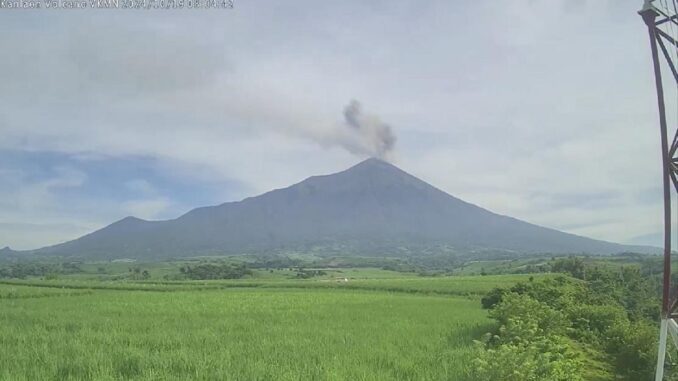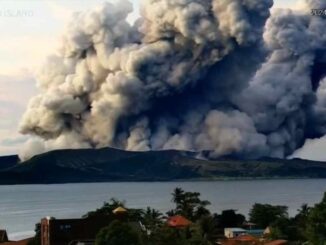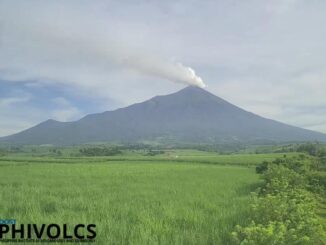
Volcanic ash were spotted being intermittently “entrained” or spewed out following continuous degassing from Kanlaon Volcano’s summit crater on Saturday, according to the Philippine Institute of Volcanology and Seismology (PHIVOLCS).
In a tweet, PHIVOLCS shared an IP camera of the activity from Kanlaon Volcano’s crater, showing that its summit is currently obscured by clouds.
Alert Level 2 prevails over Kanlaon Volcano which straddles the provinces of Negros Occidental and Negros Oriental, PHIVOLCS said.
Meanwhile in its 12:30 p.m. bulletin, PHIVOLCS said the brief episodes of gray ash were observed at 6:41 a.m., 7:01 a.m. and 8:01 a.m. and lasted two to six minutes, based on visual observations.
However, no detectable seismic or infrasound signals of these events were recorded.
“The events generated light-gray plumes that rose 500 meters above the crater before drifting southwest,” PHIVOLCS said.
Traces of ash were seen in barangays Yubo and Ara-al, La Carlota City and Barangay Sag-ang, La Castellana in Negros Occidental. Further, sulfurous fumes were also experienced in Barangay Yubo.
LIVE sa DZBB: Dir. Teresito Bacolcol, @phivolcs_dost
????: 594 kHz AM band
????: https://t.co/Jl7zdr26Yg
????: https://t.co/Jy4ATG1v0v pic.twitter.com/cvynvqGbFJ— DZBB Super Radyo (@dzbb) October 19, 2024
In a Super Radyo dzBB interview, Teresito Bacolcol, PHIVOLCS Director, said no eruption was recorded.
“Wala po tayong nai-record na eruption. Ang nangyari rito, may malakas na spewing, and sumama po rito ‘yung ash na nandoon na sa bunganga ng bulkan,” said Director Teresito Bacolcol from PHIVOLCS.
(We did not record any eruption. What happened was there was strong spewing and the ash in the mouth of the volcano came with it.)
According to the agency, volcanic sulfur dioxide emission from the summit crater of Kanlaon based on campaign Flyspec measurements on Friday averaged 2,769 tonnes/day.
PHIVOLCS said Kanlaon has been degassing increased concentrations of volcanic sulfur dioxide this year at an average rate of 3,383 tonnes/day prior to its June 3, 2024 eruption, but emission since then has been particularly elevated at a current average of 4,133 tonnes/day.
Volcanic ash in the degassing plume indicates vent conditions where volcanic gas can carry fine debris from fractured rock or even from the margins of shallow magma beneath the edifice, PHIVOLCS added.
Civil aviation authorities should thus advise pilots to avoid flying near the volcano’s summit as ash and ballistic fragments from sudden eruption can be hazardous to aircraft, it said.
Communities living beside river systems on the southern and western slopes, especially those who have experienced lahars and muddy streamflows, are advised to take precautionary measures when heavy rainfall over the volcano has been forecast or has begun, PHIVOLCS added.
“The public is reminded that Alert Level 2 (increasing unrest) prevails over Kanlaon, but that current activity may lead to eruptive unrest and an increase in the Alert Level,” PHIVOLCS warned.
“The public is strongly advised to be ready and vigilant, and to avoid entry into the four (4) kilometer-radius Permanent Danger Zone (PDZ) to minimize risks from volcanic hazards such as pyroclastic density currents, ballistic projectiles, rockfall and others,” it added.
“Maging vigilant lamang po sila kasi anytime puwedeng magkaroon ng eruption ‘yung Kanlaon Volcano,” Bacolcol said.
(They need to be vigilant because the Kanlaon Volcano can erupt anytime.”
On June 3, Kanlaon Volcano erupted, emitting plumes that rose to 5,000 meters. Alert Level 2 or “increasing unrest” was thus raised over Kanlaon Volcano from the earlier Alert Level1 which meant there is a slight increase in volcanic earthquake and steam activity.
Prior to this event, Kanlaon Volcano had almost seven years of relative inactivity.
READ: Kanlaon Volcano’s history of eruptions
—KG, GMA Integrated News





Be the first to comment